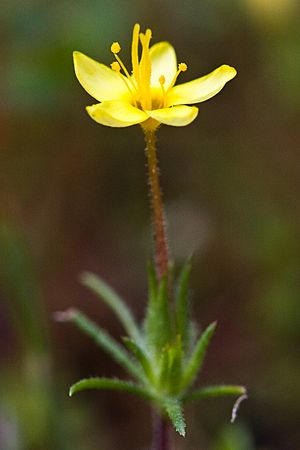Leptosiphon acicularis facts for kids
Quick facts for kids Leptosiphon acicularis |
|
|---|---|
 |
|
| Scientific classification | |
| Genus: |
Leptosiphon
|
| Species: |
acicularis
|
| Synonyms | |
|
Linanthus acicularis |
|
Leptosiphon acicularis is a small flowering plant. It's also known by its common names, bristly linanthus or bristly leptosiphon. This plant belongs to the phlox family. Sometimes, it's called Linanthus acicularis, which is another scientific name for it.
Contents
Where Does This Plant Live?
This plant, Leptosiphon acicularis, is special because it only grows in one place. It is endemic to northern California. This means it is native and unique to that area. You can find it in the California Coast Ranges, especially north of the San Francisco Bay Area.
It likes to grow in certain types of natural areas. These include chaparral (a type of shrubland), oak forests, and grassy coastal areas. It usually grows below 700 metres (2,300 ft) in elevation.
Is It Endangered?
Yes, Leptosiphon acicularis is considered a vulnerable species. This means it is at risk of becoming endangered if its habitat is not protected. Both the California Department of Fish and Wildlife and the IUCN list it as vulnerable. The California Native Plant Society also keeps track of it on their list of rare and endangered plants.
What Does This Plant Look Like?
Leptosiphon acicularis is an annual herb. This means it lives for only one growing season. It grows a hairy stem that is usually no taller than about 15 centimeters (about 6 inches).
Its leaves grow in pairs on opposite sides of the stem. Each leaf is divided into very thin, bristle-like parts. These parts can be up to a centimeter long.
Flowers and Seeds
At the top of the stem, you'll find a group of tiny yellow flowers. This group is called an inflorescence. Many needle-like sepals surround these small flowers. Sepals are like small leaves that protect the flower bud.
This plant usually blooms in the spring, from April to May.
What Does Its Name Mean?
The second part of its scientific name, acicularis, comes from Latin. It means "needle-shaped." This describes the plant's thin, bristly leaves and sepals very well!

